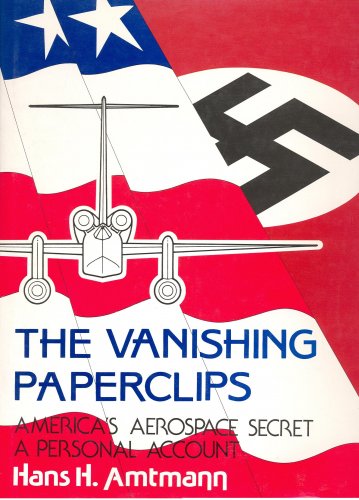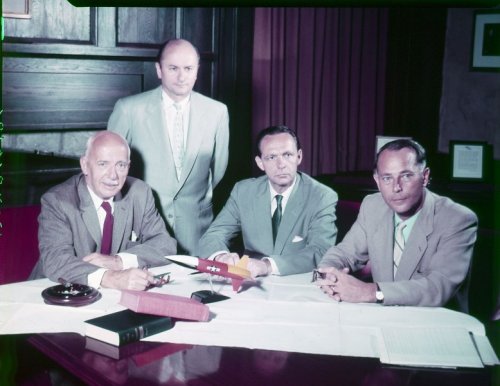Forum member Dave Stern seems to be having some computer troubles, and asked me to post this for him:
Cold War American Spacecraft Projects and the “Paperclip” connection.
The Allied Intelligence units…specifically U.S. in nature infuriated, angered, and outfoxed our allies (French, Canadians, British, and of course the Russians), by initiating “Operation Plunder,” within it being “Operation Paperclip” the collection of scientists, engineers, technicians, technology, etc., and to prevent the talented Germans from slipping out of Germany via any “ratline,” were hunted within another project called “Safeghaven:” Safehaven was specifically created to prevent wherever possible, talented Germans from slipping out of Germany, Austria and other German occupied nations, to continue their research in other nations-specifically, South America. Source; Secret Agenda, Linda Hunt, St. Martin’s Press, 1991.
During the 1950s G. L. Martin Aircraft of Baltimore, Maryland possessed an Advanced Design Teams department. Martin Design Teams presided over by George S. Trimble, was involved in pure science, future over-the-horizon advances in aeronautics, anti-gravity and its applications, nuclear propulsion for aerial vehicles, and the little publicized lenticular aircraft-spacecraft design studies plus studying and applying natural phenomena or the laws of nature, and advanced missile-spacecraft design.
Source: Aviation Week, October 18, 1953.
Martin Aircraft at their Middle-River, Maryland facility reorganized one facility into a special subsidiary that was born in 1946, and was engaged in the guided missile field. In the 1950s specific Design Teams operated within a separate unit known as RIASI-Research Institute for Advanced Study Incorporated, and performed building-block research into varied projects. This streamlined unit engaged in various missile projects, electronics, electro-mechanical weapons systems, and especially to “make the spaceship respectable,” and solve the problems of space travel. Another RIAS goal was to close the gap between basic scientific discoveries and their applications to engineering problems in their various projects.
Source: Aviation Week June 3, 1957.
The most exotic division other than RIAS was the Martin-Denver facility (where the Martin Titan series ICBM and follow-on heavy boosters), where a research unit known internally as “Force XXIV” became heavily involved in advanced space research. One aspect was to study and apply spacecraft for military applications in an area defined as a “synchronous corridor-an area 19,340 miles into space directly over the Earth’s equator. Other space-flight avenues proposed were Macro-Life spacecraft and the self-conscious, self-repairing Micro-life craft that protectively housed a human colony of space-farers. Also studied were “planetoid” or Astroid harvesting, hollowing large Astroids out to transform them into deep space exploration outside of our own Solar System. One of the more extreme thinkers based at Martin Denver was Dr. Dandridge MacFarlan Cole a high level engineer proposed some of the most extreme and advanced projects concerning human space travel. Martin Museum and other historians have spoke in very denigrating terms of Dr. Cole that border on the charge of insanity among other terms.
Aerospace author Lloyd Mallan was one of a very few writers who received the invitation for a grand tour of the Martin-Denver facilities. He wrote up the numerous space research projects at “Force XXIV” in his quite revealing book “Space Science,” based mostly upon the work of “Force XXIV.” In fact, Mr. Mallan is the only author who provided an in-depth report complete with photography, drawings, and projects being studied inside the Martin-Denver facility.
Source; Missiles and Rockets, July 19, 1965.
Time Magazine January 27, 1961 within the Science column.
Many people are familiar with the split-up of the original German Peenemunde Rocket Research Center Team-von Braun and his team surrendering to the American Forces, while the other half surrendered to the Russians. The rest is history.
What is not known is that many German lesser known scientists-engineers-technicians were involved in numerous American space projects, many of which would be applied to what the USAF secretly created immediately after the initial Russian Sputnik series were launched. The USAF SR-181 Strategic Orbital System, encompassed a series of weapon systems and support spacecraft constituting the T.O. (Table of Organization) of a tightly classified USAF organization known as EOMSF…Earth Orbital Military Space Force, with a planned operational timeframe between the late 1960s and early 1970s. This very thorough study is still classified today.
A few known German scientists and engineers absorbed into the U.S. Aerospace community that were directly involved in hypersonic boost-glider spacecraft studies were:
Bell Aircraft;
Dr. Walter R. Dornberger Bell’s chief Guided Missile Specialist cum Chief Scientist and before retirement, Vice President for Research. Responsible for Bell initiating a series of continuous rocket powered and rocket boosted reconnaissance-bombardment glider project studies, operated up to orbital speeds and altitudes, including the final follow-on to other projects…the Dyna Soar I contract.
Ing; Rudolph H Reicher joined Bell 1953, R&D on rocket engines, and in 1959 joined Boeing Airplane Company performing Propulsion Analysis and Interaction work.
Dr. Krafft A. Ehricke engineer-physicist worked for Dr. Dornberger at Bell Aircraft and left to join Convair in San Diego to work on the Atlas ICBM and Centaur Projects.
Heinz Mueller joined the Bell Aircraft Rocket Laboratory in 1950 and created “thrust chambers” and associated rocket motor work.
Dipl. Ing. Daus Chamburg-Harburg specialist in rocket-transportation and;
Dipl. Ing. Wilhelm Emil Schlitt specializing in Guidance Systems may have worked at Bell Aircraft.
Dipl. Haas or Haase of which little is known who was German and worked at Bell Aircraft on unspecified projects…either rocket engines or their Rocket Boosted reconnaissance-bombardment glider projects.
A brief list of advance and cutting-edge Bell Projects are;
MX-2145 cum MX-2276 BoMi
R459L “Hi Fi Recce” a.k.a. ”Brass Bell.”
System 118P two phase aircraft and glide-rocket study.
Study Requirement or SR-126 RoBo.
R464L Dyna Soar I cum RS-620A Dyna Soar.
Hypernias I and Hypernias II EMS…Energy Management System for Dyna Soar, SLOMAR, Lenticular Re-entry Saucer spacecraft, and all Lifting-Body Spacecraft designed by other firms.
Ramora Space Maintenance Vehicle in conjunction with Model 7045 Saucer spacecraft and their Orbital Bombardment Station or Platform.
Nuclear armed Reentry Missile in conjunction with Bell or Martin Orbital Bombardment Platforms.
REACTION CONTROL MOTOR Contracts Boeing Dyna Soar and various spacecraft projects..
Bell’s Lenticular spacecraft studies culminating in the Bell Model 7045 Modified
Lenticular Re-entry Vehicle submitted for the Apollo Project, to service Orbital Bombardment Platforms within the SR-181 Strategic Orbital System study.
Continuous USAF-NASA Contracts to continue to develop and refine Bell Aircraft’s Patented double-wall liquid and solid insulation systems for hypersonic vehicles that included winged orbital weapons systems that must negotiate a glide-reentry into earth’s sensible atmosphere. This author has now discovered that such contracts involved double-wall cooling-insulation panels, test sections, and boost-glider fuselage-wing cross sections that were refined and actually flight-tested and wind tunnel tested. Bell’s future research was agreed upon by Larry Bell and Dr. Dornberger in 1951. The double-wall cooling-insulation system contract series ran as late as 1968, such was the confidence the USAF and Bell exhibited in their lengthy research work.
G.L. Martin Aircraft;
NOTE-the following individuals were nicknamed “The Blue Angels,” despite being assigned to the Dyna Soar I competition with Bell Aircraft against the Boeing-Vought Team. The Middle-River Plant (probably the RIAS Department), where they work was painted throughout the building with two shades of Blue paint, hence the term “Blue Angels.”
Hans Multhopp; A Director and Principal Scientist under Martin Dyna Soar I boss…Mr. Bastian (Buz) Hello, also involved in design of the Martin-Bell Dyna Soar I and lifting-body spacecraft.
Dr. Peter Friedrich Jordan, structural specialist assigned to Martin-Bell Dyna Soar I Project and other Martin spacecraft projects.
Dr. Julius Friedrich Vandrey; Aerospace Physics also assigned to Dyna Soar I.
The above list of course, is by no means complete and it is curious that other Germans constituting a list of approximately 1,500 plus German-Austrian scientists and other talented people are not listed as to their employment either within the U.S. Government, Industry, the military branches and other sources.
MARTIN PROJECTS;
ASTROROCKET
START PROGRAM.
PILOT/PRIME
S-5
M-103, SV-5, X-24A X-24B, X-24C-FDL.
X-23A Prime mini-lifting body
SR-89774 Fly-back Titan II
SLOMAR
DYNA SOAR
RAPT
HL-10 STUDY
FDL-8
HASP
Martin projects listed above were applicable to inspect, maintain and support Bell or Martin’s manned and robotic Orbital Bombardment Platform proposals, crew-changes and resupply of Space Stations, etc. They offered both lifting body and lenticular plus Greatly enlarged and very heavy Dyna Soar Bombers and other spacecraft known as “SLOMAR” for a multitude of USAF missions. Martin also designed their own versions of highly modified boost-glider and lifting body spacecraft derived from the START Program. It must be noted that the plethora of U.S. Industry spacecraft designs, proposals, and Dyna Soar were to be incorporated into the still classified SR-181 Strategic Orbital System composing the hardware of the USAF planned SR-181 EOMSF…Earth Orbital Military Space Force studied between 1957-1963.
Source; numerous Martin Dyna Soar Reports and Proposal Booklets.
Boeing Airplane Company
Few German scientists and engineers worked for BAC and are unidentified.
MX-2145 Study.
SR-168 Air-Launch Glide Missile
SR-126 RoBo.
SR-178 GSS.
SR-181 Strategic Orbital System
ABMD Orbital Interceptor or Boeing nomenclature…AICBM interceptor.proposal.
SR-79500 Hypersonic Glide Misisle
ICGM
BOSS-IOC
BOSS-WEDGE
R464 a.k.a. RS620A Dyna Soar I
There are numerous contracts that either remain classified or have been destroyed by the contractor or have been buried by the Dod/USAF.
End.


